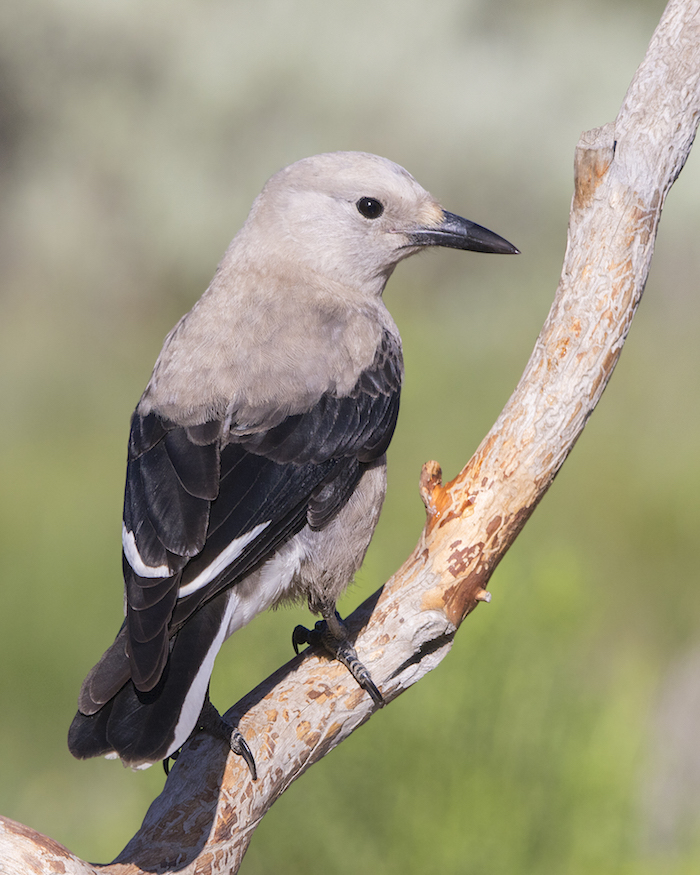
When Thomas Jefferson commissioned Lewis and Clark to explore the West, the president, a man with informed intelligence and curiosity, hoped the explorers might find new animals in that wild land. Of course they did not find the mastodon, mammoth, or “large lion-like creature” that Jefferson imagined from the new science of fossil research. But they did find numerous animals previously unknown to science, including grizzly bears, mountain goats, pronghorn antelopes, prairie dogs, and two bird species that now bear the explorers’ names.
Both of those birds live in our area, but to see one of them we’re best to hustle to the mountains now, before the snow flies and bars our way.
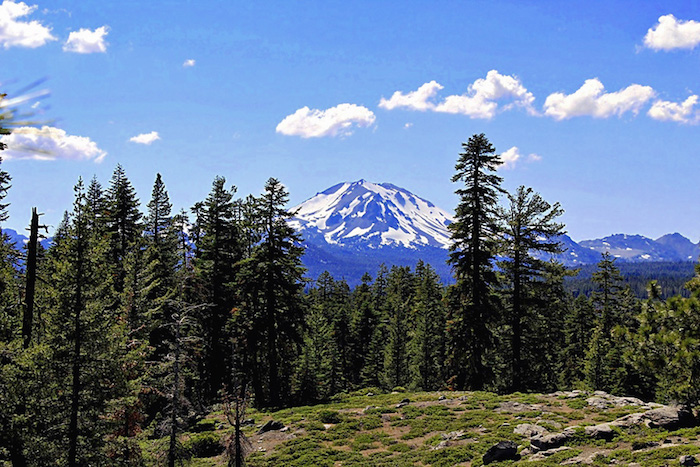
Clark’s nutcrackers live near timberline, and even their winter retreat downslope usually keeps them well above snowline. They’ve got the chops for that wintry life.
These birds are seed-eaters. Throughout the summer and fall they gather high-calorie pine nuts, tens of thousands of them, that they hide hither and yon over their miles of range. The energy-loaded seeds allow nutcrackers to survive winter conditions that send other birds to Baja.
But of course they can’t just choose to live on pine nuts at timberline. They have to have the right adaptations.
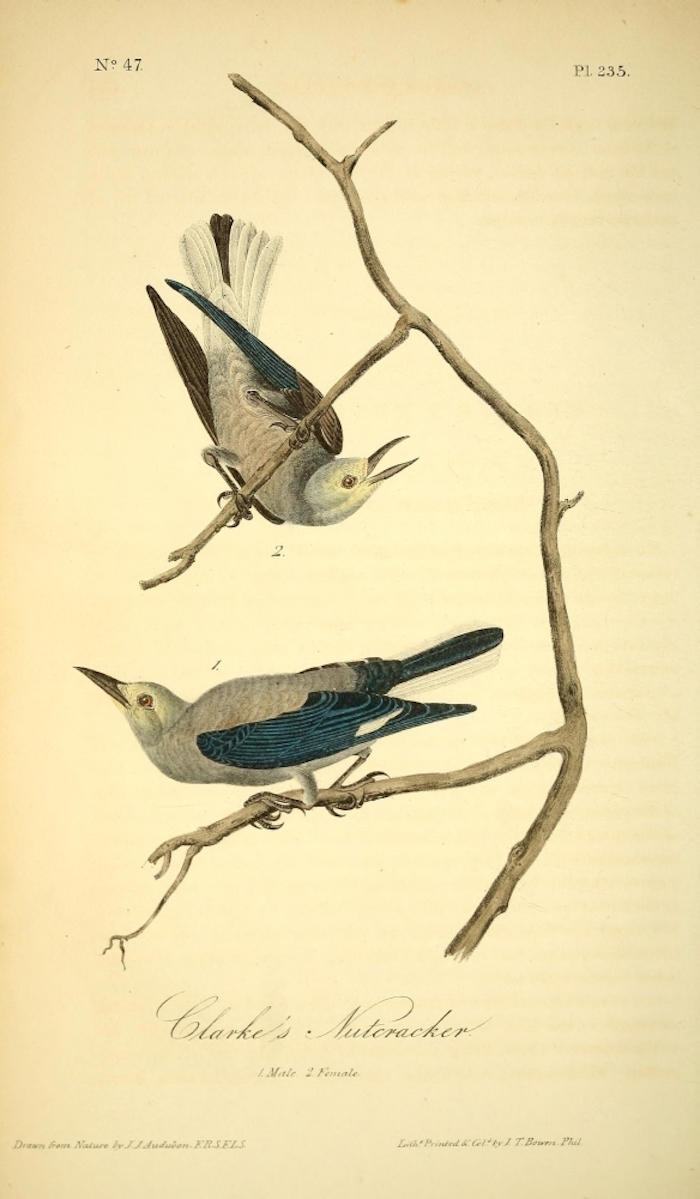
Let’s start with the bill. When William Clark first described the bird in 1805 he noted its robust bill and called it a “Bird of the woodpecker kind.” But the nutcracker is actually a corvid, closely related to jays and crows, not a woodpecker. Its powerful bill is used not for pounding through wood but for hacking into pine cones and the nuts inside them.
After extracting the seeds, the nutcrackers need to hide them for later consumption. Like ground squirrels, they have pouches in their mouths to hold the seeds for transport. Ground squirrels’ pouches are in their cheeks. Nutcrackers’ are under their tongues. They tuck scores of pine nuts into this pouch and then hide them over many square miles across their mountain homes.
Of course, if they are going to make a living by hiding seeds, the birds have to be able to find them. Nutcrackers routinely cache 30,000 pine nuts a year. They are able to find the vast majority of them, with their memory only starting to fail after six or seven months–that is, after winter is past and spring begins to bring a new supply of food to their homes.
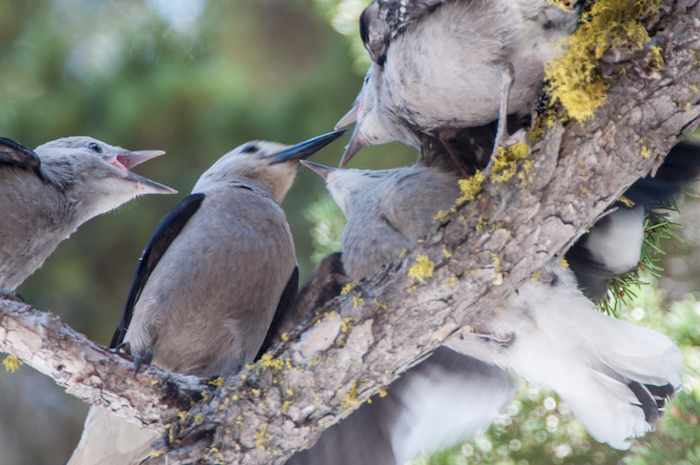
Their favorite nut, a high-nutrition preference they share with grizzly bears, comes from tree-line whitebark pines. These pine nuts have a higher concentration of calories than chocolate. With such a rich supply of energy, nutcrackers are able to give their young a head start on life. Rather than waiting for spring thaws to bring green shoots and the food source of buzzing bugs, nutcrackers begin to nest in the heart of winter, while mountain storms still howl. The energy locked into pine nuts keeps them going strong. But that energy must be passed on to the young. In most corvids, only the female tends the nest. But to successfully warm their eggs in the chill mountain world, male nutcrackers also help. They develop what typically only females do– a brood patch, an unfeathered area on their breast, that allows their warm skin to nestle right against their precious eggs. Once the eggs hatch, the young are fed the pine nuts directly.
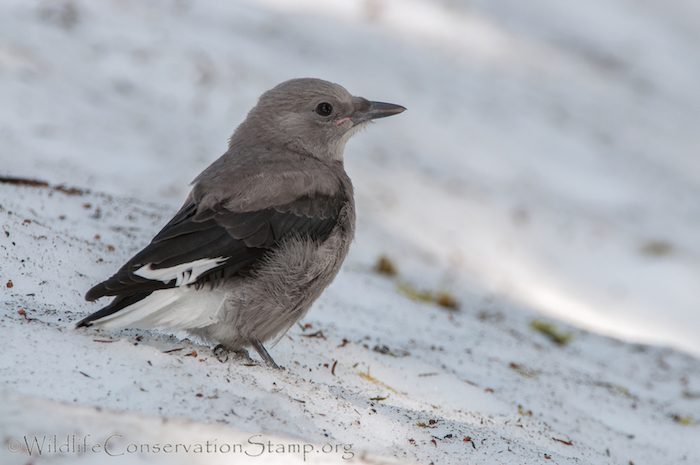
Of course the effect of nutcrackers’ success at high-altitude living doesn’t stop at the tips of their bills or their black and white tails. Whitebark pines have co-evolved with the birds and become highly dependent on them for seed dispersal. Unlike many common pine seeds, whitebark nuts don’t grow “wings” to help spread them on the wind. They count on nutcracker wings, and it is estimated that nearly all tree-line whitebark pines are planted by nutcrackers.
Unfortunately, whitebark pines are declining throughout the west. Their cones are typically opened only by nutcrackers, squirrels, and fire, so fire suppression has inhibited their reproduction. Also, warmer temperatures are spreading pinebark beetles, which are turning expanses of pine forests into matchsticks–a rather unpleasant solution to overzealous fire suppression. Most powerfully for the whitebark pines, blister rust, a fungus imported from Europe, is killing five-needled pines on a massive scale.
Fortunately, we are successfully addressing some attacks on this subalpine ecosystem. Some trees show blister rust resistance, and foresters are working to get their seeds dispersed. In Germany, foresters are putting out acorn buckets for jays to plant, and similar efforts are contemplated for whitebark pines and nutcrackers. So far the nutcrackers in most of our mountains are maintaining their populations despite the whitebark pine decline, so they may well be of service in sustaining the high-elevation ecosystems.
